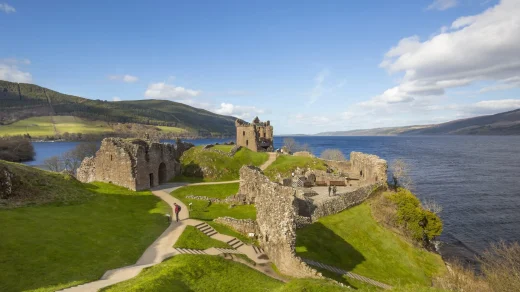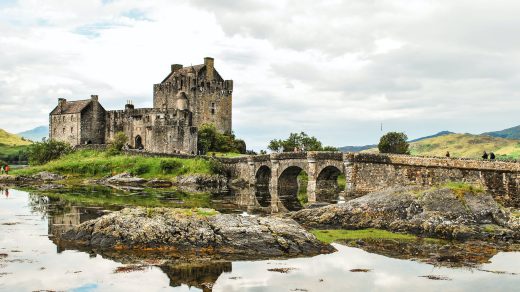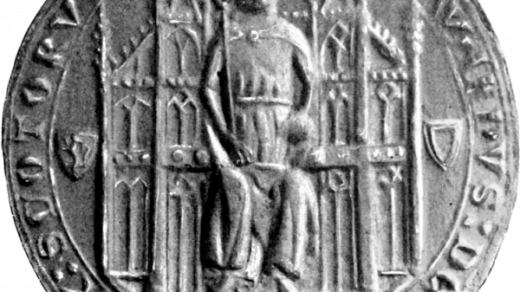The Massacre of Glencoe (Scottish Gaelic: Murt Ghlinne Comhann) took place in Glen Coe in the Highlands of Scotland on 13 February 1692, following the Jacobite uprising of 1689–92. An estimated 30 members and associates of Clan MacDonald of Glencoe were killed by government forces billeted with them, on the grounds they had not been prompt in pledging allegiance to the new monarchs, William III of England and II of Scotland and Mary II.
Main article: Glorious Revolution in Scotland
In March 1689, James II of England and VII of Scotland landed in Ireland in an attempt to regain his throne and John Graham, Viscount Dundee, recruited a small force of Highlanders for a supporting campaign in Scotland. Despite victory at the Battle of Killiecrankie on 27 July, Dundee was killed and organised Jacobite military resistance ended with defeats at the Battle of Dunkeld in August 1689 and Cromdale in May 1690.
The continuing need to police the Highlands used resources William needed for the Nine Years’ War. A peaceful Scotland was important since links between Irish and Scottish branches of the MacDonalds, as well as Scottish and Ulster Presbyterians, meant unrest in one country often spilled into the other.
The Glencoe MacDonalds was one of three Lochaber clans with a reputation for lawlessness, the others being the MacGregors and the Keppoch MacDonalds. Levies from these clans served in the Independent Companies used to suppress the Conventicles in 1678–80 and took part in the devastating Atholl raid that followed Argyll’s Rising in 1685. They also combined against their Maclean landlords in the August 1688 Battle of Maol Ruadh, putting them in the unusual position of being considered outlaws by both the previous Jacobite administration and the new Williamite one.
Oath of allegiance to William
After Killiecrankie, the Scottish government held a series of meetings with the Jacobite chiefs, offering terms that varied based on events in Ireland and Scotland. In March 1690, the Secretary of State, Lord Stair, offered a total of £12,000 for swearing allegiance to William. They agreed to do so in the June 1691 Declaration of Achallader, the Earl of Breadalbane signing for the government; in July, the Battle of Aughrim ended the War in Ireland and immediate prospects of a Restoration.
On 26 August, a Royal Proclamation offered a pardon to anyone taking the Oath prior to 1 January 1692, with severe reprisals for those who did not. Two days later, secret articles appeared, cancelling the agreement in the event of a Jacobite invasion and signed by all the attendees, including Breadalbane. Breadalbane claimed these were manufactured by Glengarry, the MacDonald chief; but Stair’s letters reflect his belief that forged or not, none of the signatories intended to keep their word. Enforcement became a key concern.
In early October, the chiefs asked James for permission to take the Oath unless he could mount an invasion before the deadline, a condition they knew to be impossible. His approval was sent on 12 December and was received by Glengarry on the 23rd, but was not shared until the 28th. It is suggested delays were caused by intrigue between Catholic Jacobites, led by Glengarry, and the Protestant majority.
As a result, MacIain of Glencoe only left for Fort William on 30 December to take the Oath from the governor, Lieutenant Colonel John Hill. Since he was not authorised to accept it, Hill sent MacIain to Inverary with a letter for the local magistrate, Sir Colin Campbell confirming his arrival before the deadline. Sir Colin administered the Oath on 6 January, after which MacIain returned home. Glengarry did not swear until 4 February, with others doing so by proxy, but only MacIain was excluded from the indemnity issued by the Scottish Privy Council.
Stair’s letter of 2 December to Breadalbane shows the intention of making an example was taken well before the deadline for the Oath but as a much bigger operation; …the clan Donell must be rooted out and Lochiel. Leave the McLeans to Argyll… In January, he wrote three letters in quick succession to Sir Thomas Livingstone, military commander in Scotland; on 7th, the intention was to ….destroy entirely the country of Lochaber, Locheal’s lands, Kippochs, Glengarrie and Glenco…; on 9th …their chieftains all being papists, it is well the vengeance falls there; for my part, I regret the MacDonalds had not divided and…Kippoch and Glenco are safe. The last on 11 January states; …my lord Argile tells me Glenco hath not taken the oaths at which I rejoice….
Parliament passed a Decree of Forfeiture in 1690, depriving Glengarry of his lands, but he continued to hold Invergarry Castle, whose garrison included the senior Jacobite officers Alexander Cannon and Thomas Buchan. This suggests the Episcopalian Glencoe MacDonalds only replaced the Catholic Glengarry as the target on 11 January; MacIain’s son John MacDonald told the 1695 Commission the soldiers came to Glencoe from the north ‘…Glengarry’s house being reduced.’
After two years of negotiations, Stair was under pressure to ensure the deal stuck, while Argyll was competing for political influence with his kinsman Breadalbane, who also found it expedient to concur with the plan. Glengarry was pardoned and his lands returned while maintaining his reputation at the Jacobite court by being the last to swear and ensuring Cannon and Buchan received safe conduct to France in March 1692. In summary, the Glencoe MacDonalds were a small clan with few friends and powerful enemies.
Massacre
In late January 1692, two companies or approximately 120 men from the Earl of Argyll’s Regiment of Foot arrived in Glencoe from Invergarry. Their commander was Robert Campbell of Glenlyon, a local landowner whose niece was married to one of MacIain’s sons. Campbell carried orders for ‘free quarter’, an established alternative to paying taxes in what was a largely non-cash society. The Glencoe MacDonalds themselves were similarly billeted on the Campbells when serving with the Highland levies used to police Argyll in 1678.
Highland regiments were formed by first appointing Captains, each responsible for recruiting sixty men from his own estates. Muster rolls for the regiment from October 1691 show the vast majority came from Argyll, including Cowal and Kintyre, areas settled by Lowlander migrants and badly hit by the Atholl raids of 1685 and 1686.
On 12 February, Hill issued orders instructing Hamilton to take 400 men and block the northern exits from Glencoe at Kinlochleven. Another 400 men from Argyll’s Regiment under Major Duncanson would join Glenlyon’s detachment in the south and sweep northwards up the glen, killing anyone they found, removing property and burning houses.
On the evening of 12 February, Glenlyon received written orders from Duncanson carried by another Argyll officer, Captan Thomas Drummond; their tone shows doubts as to his ability or willingness to carry them out. See that this be putt in execution without feud or favour, else you may expect to be dealt with as one not true to King nor Government, nor a man fitt to carry Commissione in the Kings service. As Captain of the Argylls’ Grenadier company, Drummond was senior to Glenlyon; his presence appears to have been to ensure the orders were enforced since witnesses gave evidence he shot two people who asked Glenlyon for mercy.
MacIain was killed, but his two sons escaped and the 1695 Commission was given various figures for total deaths. The often-quoted figure of 38 was based on hearsay evidence from Hamilton’s men, while the MacDonalds claimed ‘the number they knew to be slaine were about 25.’ Recent estimates put total deaths resulting from the Massacre as ‘around 30’, while claims others died of exposure have not been substantiated.
Casualties would have been higher, but, whether by accident or design, Hamilton and Duncanson arrived after the killings had finished. Duncanson was two hours late, only joining Glenlyon at the southern end at 7:00 am, after which they advanced up the glen burning houses and removing livestock. Hamilton was not in a position at Kinlochleven until 11:00; his detachment included two lieutenants, Francis Farquhar and Gilbert Kennedy who often appear in anecdotes claiming they ‘broke their swords rather than carry out their orders.’ This differs from their testimony to the Commission and is unlikely since they arrived hours after the killings, which were carried out at the opposite end of the glen.
In his letters of 30 January to Lieutenant Colonel Hamilton and Colonel Hill, Stair expresses concern the MacDonalds would escape if warned and emphasises the need for secrecy. This correlates with evidence from James Campbell, one of Glenlyon’s company, stating they had no knowledge of the plan until the morning of 13 February.
In May, fears of a French invasion meant the Argylls were posted to Brentford in England, then to Flanders, where they remained until the Nine Years’ War ended in 1697 and the regiment was disbanded. No action was taken against those involved; Glenlyon died of disease in Bruges in August 1696, Duncanson became a Colonel and was killed fighting in Spain in May 1705, while Drummond featured in another famous Scottish disaster, the Darien Scheme.
Inquiry.
The killings first came to public attention when a copy of Glenlyon’s orders, alleged to have been left in an Edinburgh coffee house, was smuggled to France and published in the Paris Gazette of 12 April 1692. Despite criticism of the Scottish government, there was little sympathy for the MacDonalds; the military commander in Scotland, Viscount Teviot wrote that ‘it’s not that anyone thinks the thieving tribe did not deserve to be destroyed but that it should have been done by those quartered amongst them makes a great noise.’ The impetus behind an inquiry was political; as a member of James’ administration, Stair was unpopular with Jacobites and supporters of the new regime.
The killing of the De Witt brothers, The Hague 1672; the Massacre first appeared as a minor issue in a broadsheet accusing William of complicity in their murder
Various observers argued Glencoe showed the Highlands could not be controlled purely by force, including Colonel Hill, who was generally sympathetic towards Highlanders and claimed even in Lochaber, a single person may travell safley where he will witout harme. He argued lawlessness was deliberately encouraged by leaders like Glengarry but that ‘the midle sort of Gentrey and Commons….never got anything but hurt’ from it. The 1693 Highland Judicial Commission tried to solve this by making it easier to use the law to resolve minor issues like cattle-theft. As Hill predicted, it was undermined by the clan chiefs, since it diminished control over their tenants and clansmen.
In 1695, the massacre was referenced in a pamphlet written by Charles Leslie, a nonjuring Church of Ireland Episcopalian priest who moved to London in 1690 and produced pro-Jacobite articles until his death in 1721. This focused on was William’s alleged complicity in the 1672 death of Dutch Republican leader Johan de Witt, with the additions of Glencoe and a number of other crimes.
A Parliamentary Commission was set up to determine whether there was a case to answer under the charge of ‘Slaughter under trust.’ This 1587 law was intended to reduce endemic feuding by requiring opponents to use the Crown to settle disputes and applied to murder committed in ‘cold-blood’, i.e., once articles of surrender had been agreed or hospitality accepted. This was subject to interpretation; in 1597, James MacDonald was charged under the law for assembling 200 men outside his parents’ house, locking them inside and setting fire to it but this was later judged ‘hot-blooded’ and excluded.
As both a capital offence and treason, it was an awkward weapon with which to attack Stair, as William himself signed the orders and the intent was widely known in government circles. The Commission, therefore, focused on whether participants exceeded their orders, not their legality; it concluded Stair and Hamilton had a case to answer but left the decision to William. While Stair was dismissed as Secretary of State, he returned to government in 1700 and was made an earl by the last Stuart monarch, Queen Anne. An application by the surviving Glencoe MacDonalds for compensation was ignored; they rebuilt their houses and participated in both the 1715 and 1745 Jacobite risings.
Aftermath
Despite its reputation, Glencoe was not particularly unusual; other examples involving the MacDonalds include the 1578 Battle of the Spoiling Dyke and the Dunaverty Massacre in 1647. Breach of hospitality was less common, but far from unique; the charge of ‘Slaughter under trust’ was first used in 1588 to prosecute Lachlan Maclean, whose objections to his new stepfather, John MacDonald, resulted in the murder of 18 members of the MacDonald wedding party.
Its continuing significance derives from being used as a symbol of post-1688 oppression; in 1745, Prince Charles ordered Leslie’s pamphlet and the 1695 Parliamentary minutes to be reprinted in the Edinburgh Caledonian Mercury. It faded from view until 1859, when it re-appeared in Macaulay’s History; Macaulay sought to exonerate William from every charge made by Leslie, including the Massacre and is the origin of the claim it was part of a Campbell-MacDonald feud.
After the Massacre of Glencoe by Peter Graham, 1889; the survivors seek refuge.
Victorian Scotland developed values that were pro-Union and pro-Empire, while also being uniquely Scottish. Historical divisions meant this was largely expressed through shared cultural identity, while the study of Scottish history itself virtually disappeared from universities. Glencoe became part of a focus on ‘the emotional trappings of the Scottish past…bonnie Scotland of the bens and glens and misty shieling, the Jacobites, Mary, Queen of Scots, tartan mania and the raising of historical statuary.’
Even when Scottish history re-emerged in the 1950s, Leslie’s perspectives continued to shape views of William’s reign as particularly disastrous for Scotland. This meant Glencoe became part of a series of incidents, including the Darien scheme, the famine of the late 1690s, and ultimately Union in 1707.
The Massacre is the centre of an annual ceremony initiated in 1930 by Mary Rankin from Taigh a’ phuirt, Glencoe, and continued by her family. On 13 February each year the Clan Donald Society holds a wreath-laying ceremony attended by members from around the world at the Upper Carnoch memorial; this is a tapering Celtic cross designed in 1883 by MacDonald of Aberdeen and located at the eastern end of Glencoe village, formerly known as Carnoch.
Its continuing emotional power was demonstrated in 1998, when a plaque was installed at a granite boulder south of Carnach.[45] Originally known as the ‘Soldier’s Stone’, in the late 19th century, it was renamed Clach Eanruig, or ‘Henry’s Stone’. It is currently named the Henderson Stone, after the family reputed to be pipers to MacIain.




I was recommended this website by my cousin I am not sure whether this post is written by him as nobody else know such detailed about my trouble You are amazing Thanks